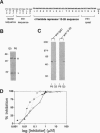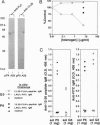Abstract
Isologous and heterologous immunoglobulins have been shown to be extremely effective as tolerogenic carriers for nearly 30 years. The efficacy of these proteins is due in part to their long half-life in vivo, as well as their ability to crosslink surface IgM with Fc receptors. The concept of using IgG as a carrier molecule to induce unresponsiveness in the adult immune system has been exploited for simple haptens, such as nucleosides, as well as for peptides. To further evaluate the in vivo potential of these molecules for inducing tolerance to a defined epitope, we have engineered a fusion protein of mouse IgG1 with the immunodominant epitope 12-26 from bacteriophage lambda cI repressor protein. This 15-mer, which contains both a B-cell and T-cell epitope, has been fused in-frame to the N terminus of a mouse heavy chain IgG1 construct, thus creating a "genetic hapten-carrier" system. We describe a novel in vitro and in vivo experimental system for studying the feasibility of engineered tolerogens, consisting of a recombinant flagellin challenge antigen and a murine IgG1 tolerogen, both expressing the lambda repressor epitope 12-26. Herein, we show that peptide-grafted IgG molecules injected i.v., or expressed by transfected, autologous B cells, can efficiently modulate the cellular and humoral immune responses to immunodominant epitopes. This model displays the feasibility of "tailor-designing" immune responses to whole antigens by selecting epitopes for either tolerance or immunity.
Full text
PDF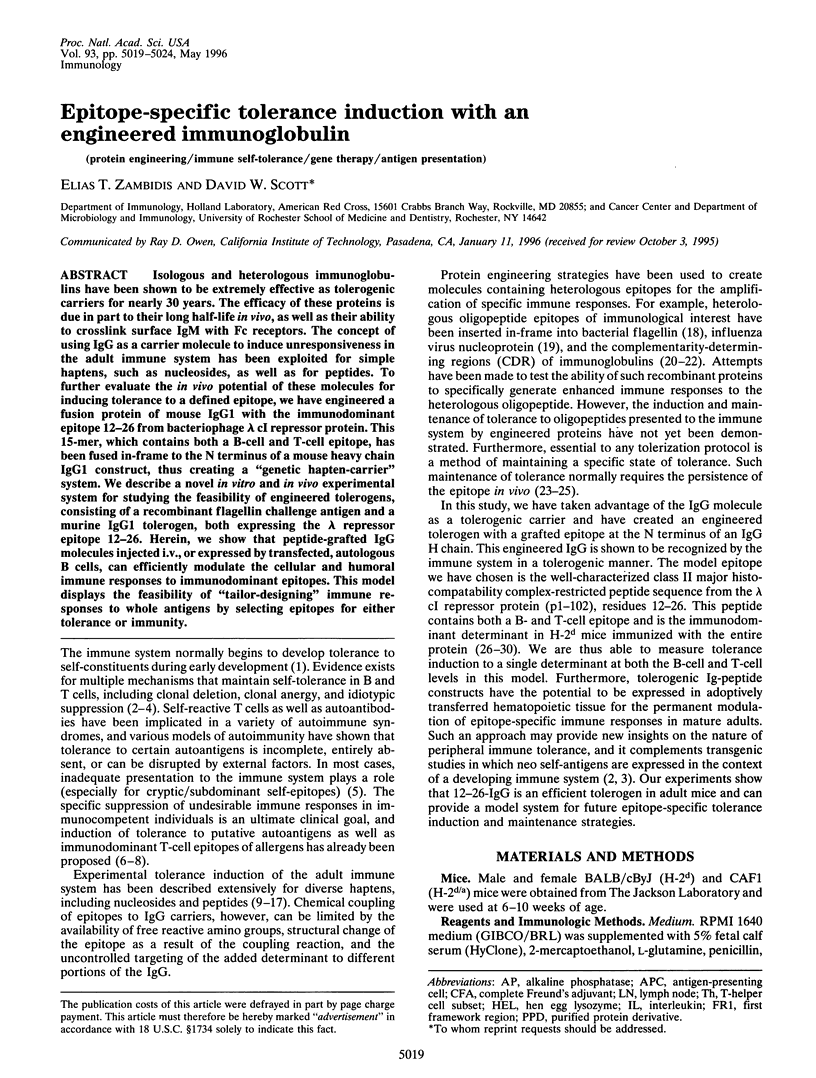
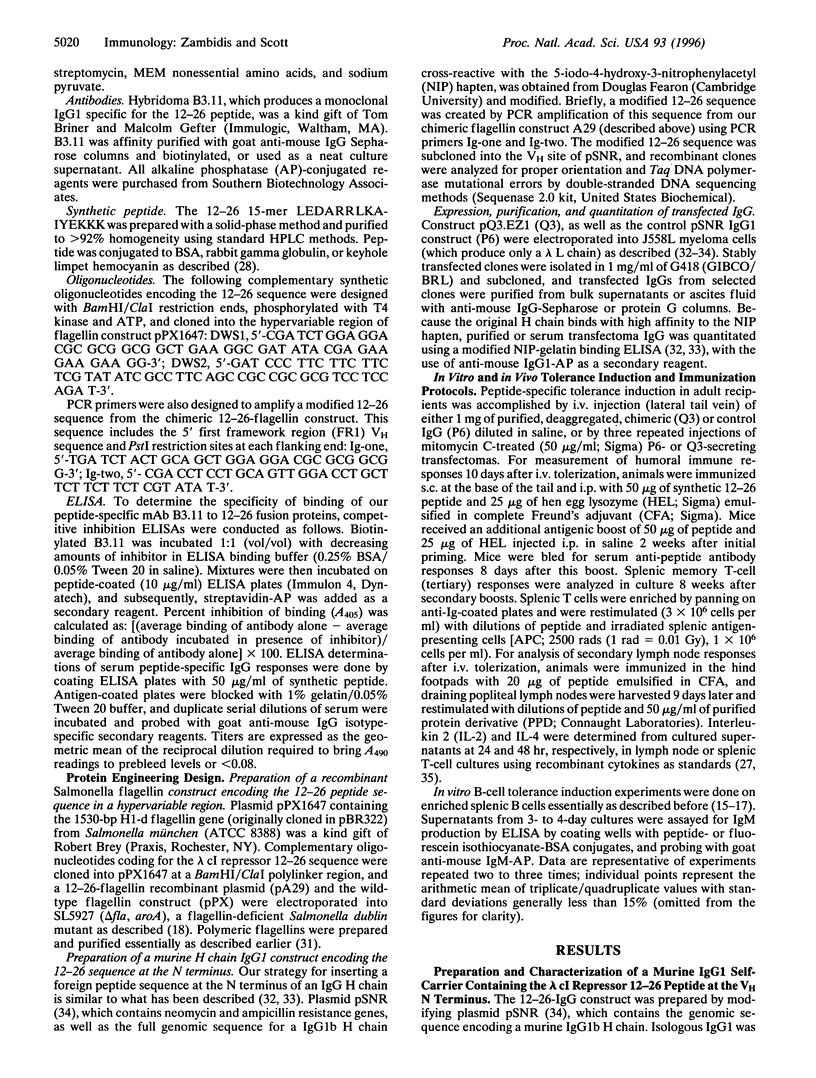
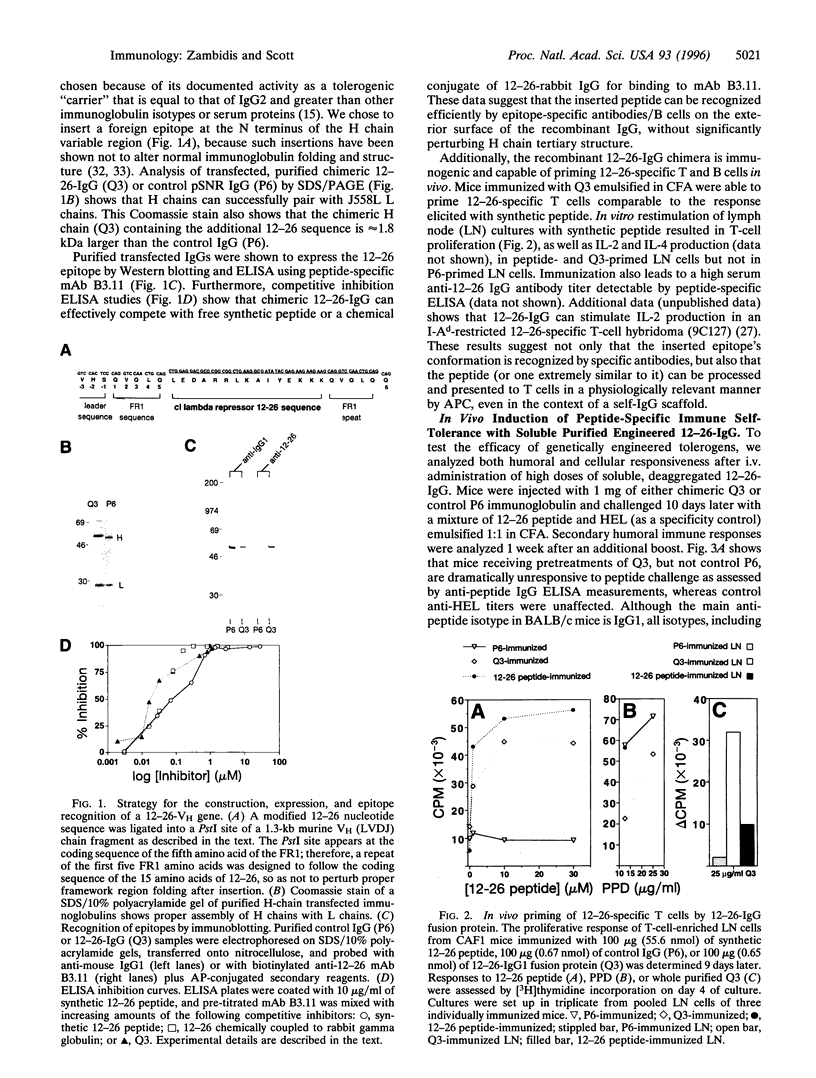
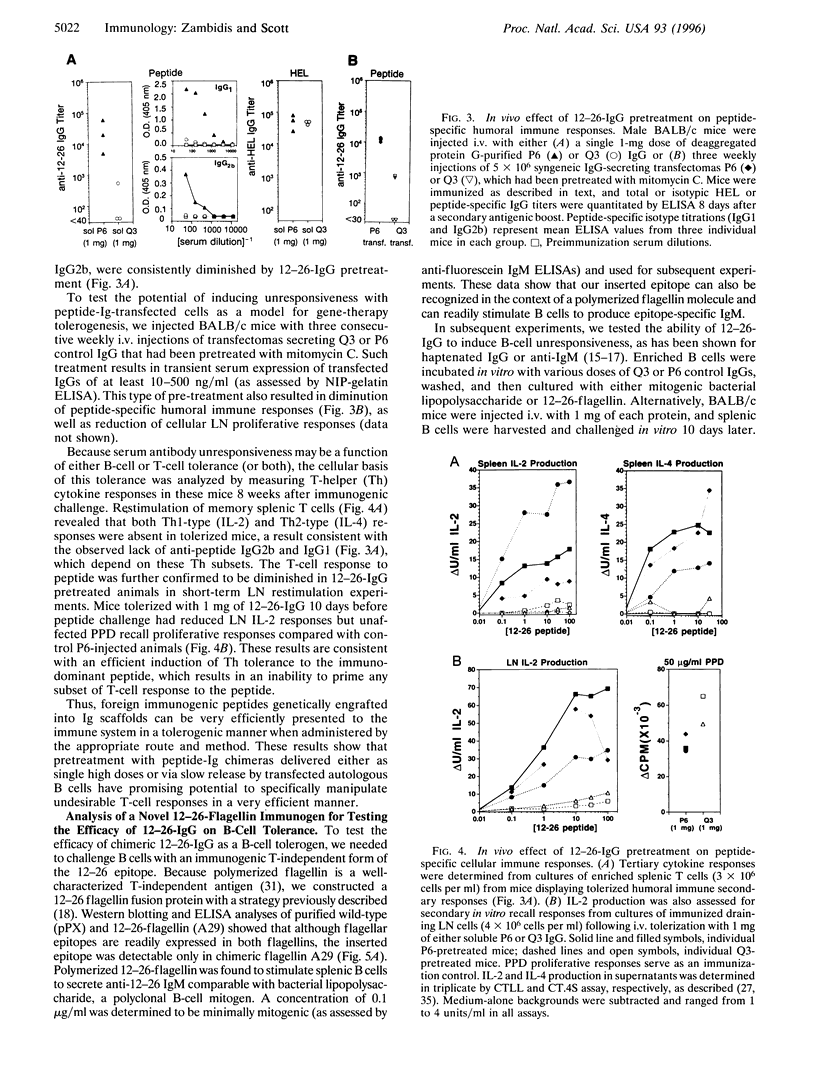
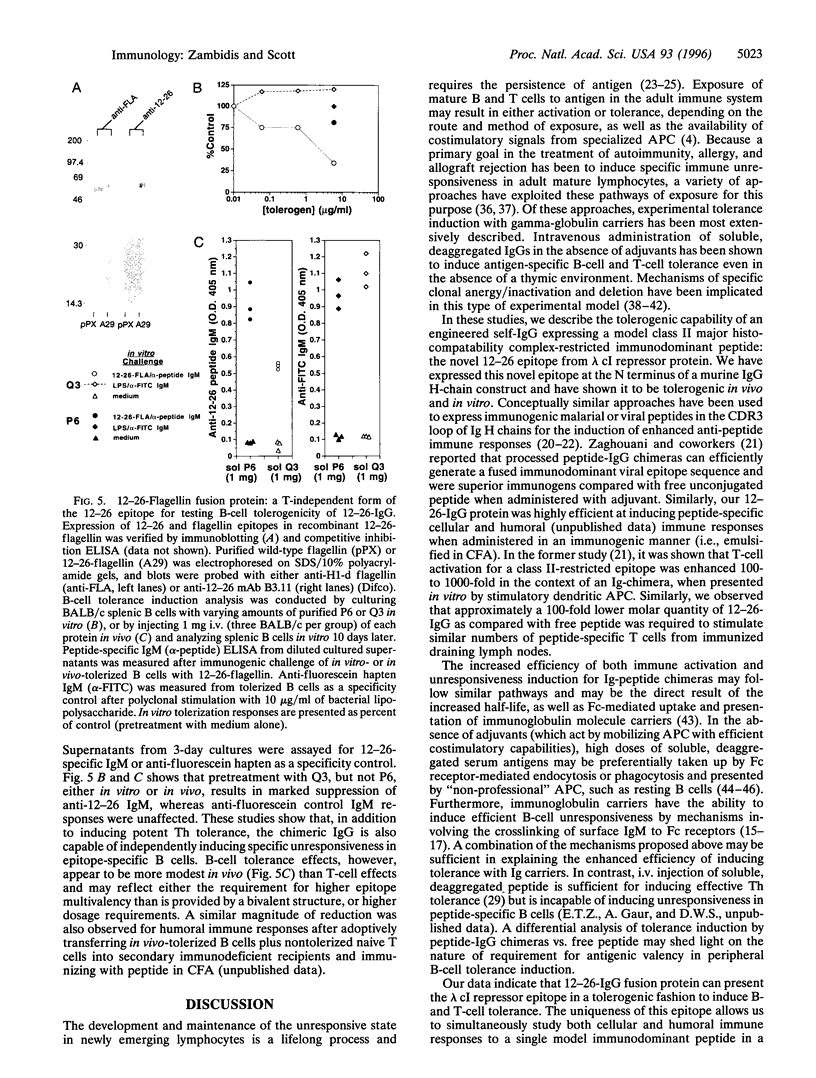
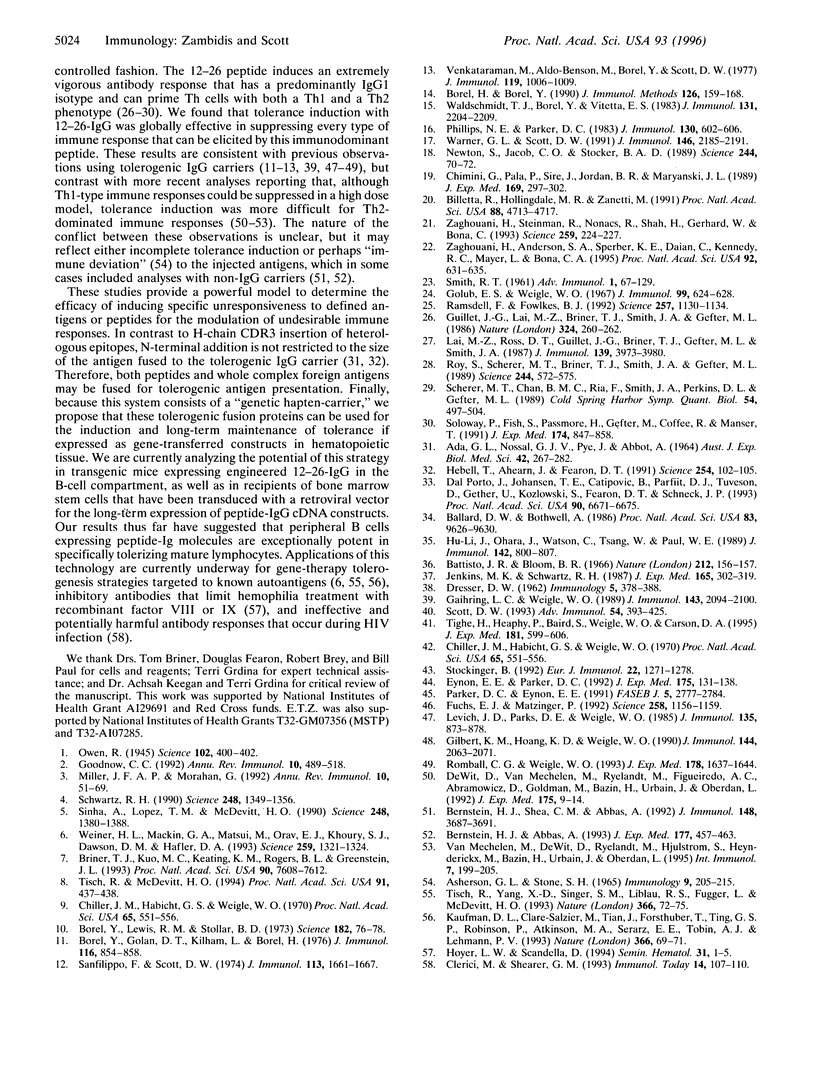
Images in this article
Selected References
These references are in PubMed. This may not be the complete list of references from this article.
- ADA G. L., NOSSAL G. J., PYE J., ABBOT A. ANTIGENS IN IMMUNITY. I. PREPARATION AND PROPERTIES OF FLAGELLAR ANTIGENS FROM SALMONELLA ADELAIDE. Aust J Exp Biol Med Sci. 1964 Jun;42:267–282. [PubMed] [Google Scholar]
- Asherson G. L., Stone S. H. Selective and specific inhibition of 24 hour skin reactions in the guinea-pig. I. Immune deviation: description of the phenomenon and the effect of splenectomy. Immunology. 1965 Sep;9(3):205–217. [PMC free article] [PubMed] [Google Scholar]
- Ballard D. W., Bothwell A. Mutational analysis of the immunoglobulin heavy chain promoter region. Proc Natl Acad Sci U S A. 1986 Dec;83(24):9626–9630. doi: 10.1073/pnas.83.24.9626. [DOI] [PMC free article] [PubMed] [Google Scholar]
- Battisto J. R., Bloom B. R. Dual immunological unresponsiveness induced by cell membrane coupled hapten or antigen. Nature. 1966 Oct 8;212(5058):156–157. doi: 10.1038/212156a0. [DOI] [PubMed] [Google Scholar]
- Billetta R., Hollingdale M. R., Zanetti M. Immunogenicity of an engineered internal image antibody. Proc Natl Acad Sci U S A. 1991 Jun 1;88(11):4713–4717. doi: 10.1073/pnas.88.11.4713. [DOI] [PMC free article] [PubMed] [Google Scholar]
- Borel H., Borel Y. A novel technique to link either proteins or peptides to gammaglobulin to construct tolerogens. J Immunol Methods. 1990 Feb 9;126(2):159–168. doi: 10.1016/0022-1759(90)90146-m. [DOI] [PubMed] [Google Scholar]
- Borel Y., Golan D. T., Kilham L., Borel H. Carrier determined tolerance with various subclasses of murine myeloma IgG. J Immunol. 1976 Mar;116(3):854–858. [PubMed] [Google Scholar]
- Borel Y., Lewis R. M., Stollar B. D. Prevention of murine lupus nephritis by carrier-dependent induction of immunologic tolerance to denatured DNA. Science. 1973 Oct 5;182(4107):76–78. doi: 10.1126/science.182.4107.76. [DOI] [PubMed] [Google Scholar]
- Briner T. J., Kuo M. C., Keating K. M., Rogers B. L., Greenstein J. L. Peripheral T-cell tolerance induced in naive and primed mice by subcutaneous injection of peptides from the major cat allergen Fel d I. Proc Natl Acad Sci U S A. 1993 Aug 15;90(16):7608–7612. doi: 10.1073/pnas.90.16.7608. [DOI] [PMC free article] [PubMed] [Google Scholar]
- Burstein H. J., Abbas A. K. In vivo role of interleukin 4 in T cell tolerance induced by aqueous protein antigen. J Exp Med. 1993 Feb 1;177(2):457–463. doi: 10.1084/jem.177.2.457. [DOI] [PMC free article] [PubMed] [Google Scholar]
- Burstein H. J., Shea C. M., Abbas A. K. Aqueous antigens induce in vivo tolerance selectively in IL-2- and IFN-gamma-producing (Th1) cells. J Immunol. 1992 Jun 15;148(12):3687–3691. [PubMed] [Google Scholar]
- Chiller J. M., Habicht G. S., Weigle W. O. Cellular sites of immunologic unresponsiveness. Proc Natl Acad Sci U S A. 1970 Mar;65(3):551–556. doi: 10.1073/pnas.65.3.551. [DOI] [PMC free article] [PubMed] [Google Scholar]
- Chiller J. M., Habicht G. S., Weigle W. O. Cellular sites of immunologic unresponsiveness. Proc Natl Acad Sci U S A. 1970 Mar;65(3):551–556. doi: 10.1073/pnas.65.3.551. [DOI] [PMC free article] [PubMed] [Google Scholar]
- Chimini G., Pala P., Sire J., Jordan B. R., Maryanski J. L. Recognition of oligonucleotide-encoded T cell epitopes introduced into a gene unrelated to the original antigen. J Exp Med. 1989 Jan 1;169(1):297–302. doi: 10.1084/jem.169.1.297. [DOI] [PMC free article] [PubMed] [Google Scholar]
- Clerici M., Shearer G. M. A TH1-->TH2 switch is a critical step in the etiology of HIV infection. Immunol Today. 1993 Mar;14(3):107–111. doi: 10.1016/0167-5699(93)90208-3. [DOI] [PubMed] [Google Scholar]
- DRESSER D. W. Specific inhibition of antibody production. II. Paralysis induced in adult mice by small quantities of protein antigen. Immunology. 1962 May;5:378–388. [PMC free article] [PubMed] [Google Scholar]
- Dal Porto J., Johansen T. E., Catipović B., Parfiit D. J., Tuveson D., Gether U., Kozlowski S., Fearon D. T., Schneck J. P. A soluble divalent class I major histocompatibility complex molecule inhibits alloreactive T cells at nanomolar concentrations. Proc Natl Acad Sci U S A. 1993 Jul 15;90(14):6671–6675. doi: 10.1073/pnas.90.14.6671. [DOI] [PMC free article] [PubMed] [Google Scholar]
- De Wit D., Van Mechelen M., Ryelandt M., Figueiredo A. C., Abramowicz D., Goldman M., Bazin H., Urbain J., Leo O. The injection of deaggregated gamma globulins in adult mice induces antigen-specific unresponsiveness of T helper type 1 but not type 2 lymphocytes. J Exp Med. 1992 Jan 1;175(1):9–14. doi: 10.1084/jem.175.1.9. [DOI] [PMC free article] [PubMed] [Google Scholar]
- Eynon E. E., Parker D. C. Small B cells as antigen-presenting cells in the induction of tolerance to soluble protein antigens. J Exp Med. 1992 Jan 1;175(1):131–138. doi: 10.1084/jem.175.1.131. [DOI] [PMC free article] [PubMed] [Google Scholar]
- Fuchs E. J., Matzinger P. B cells turn off virgin but not memory T cells. Science. 1992 Nov 13;258(5085):1156–1159. doi: 10.1126/science.1439825. [DOI] [PubMed] [Google Scholar]
- Gahring L. C., Weigle W. O. The induction of peripheral T cell unresponsiveness in adult mice by monomeric human gamma-globulin. J Immunol. 1989 Oct 1;143(7):2094–2100. [PubMed] [Google Scholar]
- Gilbert K. M., Hoang K. D., Weigle W. O. Th1 and Th2 clones differ in their response to a tolerogenic signal. J Immunol. 1990 Mar 15;144(6):2063–2071. [PubMed] [Google Scholar]
- Golub E. S., Weigle W. O. Studies on the induction of immunologic unresponsiveness. II. Kinetics. J Immunol. 1967 Sep;99(3):624–628. [PubMed] [Google Scholar]
- Goodnow C. C. Transgenic mice and analysis of B-cell tolerance. Annu Rev Immunol. 1992;10:489–518. doi: 10.1146/annurev.iy.10.040192.002421. [DOI] [PubMed] [Google Scholar]
- Guillet J. G., Lai M. Z., Briner T. J., Smith J. A., Gefter M. L. Interaction of peptide antigens and class II major histocompatibility complex antigens. Nature. 1986 Nov 20;324(6094):260–262. doi: 10.1038/324260a0. [DOI] [PubMed] [Google Scholar]
- Hebell T., Ahearn J. M., Fearon D. T. Suppression of the immune response by a soluble complement receptor of B lymphocytes. Science. 1991 Oct 4;254(5028):102–105. doi: 10.1126/science.1718035. [DOI] [PubMed] [Google Scholar]
- Hoyer L. W., Scandella D. Factor VIII inhibitors: structure and function in autoantibody and hemophilia A patients. Semin Hematol. 1994 Apr;31(2 Suppl 4):1–5. [PubMed] [Google Scholar]
- Hu-Li J., Ohara J., Watson C., Tsang W., Paul W. E. Derivation of a T cell line that is highly responsive to IL-4 and IL-2 (CT.4R) and of an IL-2 hyporesponsive mutant of that line (CT.4S). J Immunol. 1989 Feb 1;142(3):800–807. [PubMed] [Google Scholar]
- Jenkins M. K., Schwartz R. H. Antigen presentation by chemically modified splenocytes induces antigen-specific T cell unresponsiveness in vitro and in vivo. J Exp Med. 1987 Feb 1;165(2):302–319. doi: 10.1084/jem.165.2.302. [DOI] [PMC free article] [PubMed] [Google Scholar]
- Kaufman D. L., Clare-Salzler M., Tian J., Forsthuber T., Ting G. S., Robinson P., Atkinson M. A., Sercarz E. E., Tobin A. J., Lehmann P. V. Spontaneous loss of T-cell tolerance to glutamic acid decarboxylase in murine insulin-dependent diabetes. Nature. 1993 Nov 4;366(6450):69–72. doi: 10.1038/366069a0. [DOI] [PMC free article] [PubMed] [Google Scholar]
- Lai M. Z., Ross D. T., Guillet J. G., Briner T. J., Gefter M. L., Smith J. A. T lymphocyte response to bacteriophage lambda repressor cI protein. Recognition of the same peptide presented by Ia molecules of different haplotypes. J Immunol. 1987 Dec 15;139(12):3973–3980. [PubMed] [Google Scholar]
- Levich J. D., Parks D. E., Weigle W. O. Tolerance induction in antigen-specific helper T cell clones and lines in vitro. J Immunol. 1985 Aug;135(2):873–878. [PubMed] [Google Scholar]
- Miller J. F., Morahan G. Peripheral T cell tolerance. Annu Rev Immunol. 1992;10:51–69. doi: 10.1146/annurev.iy.10.040192.000411. [DOI] [PubMed] [Google Scholar]
- Newton S. M., Jacob C. O., Stocker B. A. Immune response to cholera toxin epitope inserted in Salmonella flagellin. Science. 1989 Apr 7;244(4900):70–72. doi: 10.1126/science.2468182. [DOI] [PubMed] [Google Scholar]
- Owen R. D. IMMUNOGENETIC CONSEQUENCES OF VASCULAR ANASTOMOSES BETWEEN BOVINE TWINS. Science. 1945 Oct 19;102(2651):400–401. doi: 10.1126/science.102.2651.400. [DOI] [PubMed] [Google Scholar]
- Parker D. C., Eynon E. E. Antigen presentation in acquired immunological tolerance. FASEB J. 1991 Oct;5(13):2777–2784. doi: 10.1096/fasebj.5.13.1916102. [DOI] [PubMed] [Google Scholar]
- Phillips N. E., Parker D. C. Fc-dependent inhibition of mouse B cell activation by whole anti-mu antibodies. J Immunol. 1983 Feb;130(2):602–606. [PubMed] [Google Scholar]
- Ramsdell F., Fowlkes B. J. Maintenance of in vivo tolerance by persistence of antigen. Science. 1992 Aug 21;257(5073):1130–1134. doi: 10.1126/science.257.5073.1130. [DOI] [PubMed] [Google Scholar]
- Romball C. G., Weigle W. O. In vivo induction of tolerance in murine CD4+ cell subsets. J Exp Med. 1993 Nov 1;178(5):1637–1644. doi: 10.1084/jem.178.5.1637. [DOI] [PMC free article] [PubMed] [Google Scholar]
- Roy S., Scherer M. T., Briner T. J., Smith J. A., Gefter M. L. Murine MHC polymorphism and T cell specificities. Science. 1989 May 5;244(4904):572–575. doi: 10.1126/science.2470147. [DOI] [PubMed] [Google Scholar]
- Sanfilippo F., Scott D. W. Cellular events in tolerance. III. Carrier tolerance as a model for T cell unresponsiveness. J Immunol. 1974 Dec;113(6):1661–1667. [PubMed] [Google Scholar]
- Scherer M. T., Chan B. M., Ria F., Smith J. A., Perkins D. L., Gefter M. L. Control of cellular and humoral immune responses by peptides containing T-cell epitopes. Cold Spring Harb Symp Quant Biol. 1989;54(Pt 1):497–504. doi: 10.1101/sqb.1989.054.01.059. [DOI] [PubMed] [Google Scholar]
- Schwartz R. H. A cell culture model for T lymphocyte clonal anergy. Science. 1990 Jun 15;248(4961):1349–1356. doi: 10.1126/science.2113314. [DOI] [PubMed] [Google Scholar]
- Scott D. W. Analysis of B cell tolerance in vitro. Adv Immunol. 1993;54:393–425. doi: 10.1016/s0065-2776(08)60539-8. [DOI] [PubMed] [Google Scholar]
- Sinha A. A., Lopez M. T., McDevitt H. O. Autoimmune diseases: the failure of self tolerance. Science. 1990 Jun 15;248(4961):1380–1388. doi: 10.1126/science.1972595. [DOI] [PubMed] [Google Scholar]
- Soloway P., Fish S., Passmore H., Gefter M., Coffee R., Manser T. Regulation of the immune response to peptide antigens: differential induction of immediate-type hypersensitivity and T cell proliferation due to changes in either peptide structure or major histocompatibility complex haplotype. J Exp Med. 1991 Oct 1;174(4):847–858. doi: 10.1084/jem.174.4.847. [DOI] [PMC free article] [PubMed] [Google Scholar]
- Stockinger B. Capacity of antigen uptake by B cells, fibroblasts or macrophages determines efficiency of presentation of a soluble self antigen (C5) to T lymphocytes. Eur J Immunol. 1992 May;22(5):1271–1278. doi: 10.1002/eji.1830220523. [DOI] [PubMed] [Google Scholar]
- Tighe H., Heaphy P., Baird S., Weigle W. O., Carson D. A. Human immunoglobulin (IgG) induced deletion of IgM rheumatoid factor B cells in transgenic mice. J Exp Med. 1995 Feb 1;181(2):599–606. doi: 10.1084/jem.181.2.599. [DOI] [PMC free article] [PubMed] [Google Scholar]
- Tisch R., McDevitt H. O. Antigen-specific immunotherapy: is it a real possibility to combat T-cell-mediated autoimmunity? Proc Natl Acad Sci U S A. 1994 Jan 18;91(2):437–438. doi: 10.1073/pnas.91.2.437. [DOI] [PMC free article] [PubMed] [Google Scholar]
- Tisch R., Yang X. D., Singer S. M., Liblau R. S., Fugger L., McDevitt H. O. Immune response to glutamic acid decarboxylase correlates with insulitis in non-obese diabetic mice. Nature. 1993 Nov 4;366(6450):72–75. doi: 10.1038/366072a0. [DOI] [PubMed] [Google Scholar]
- Van Mechelen M., De Wit D., Ryelandt M., Hjulström S., Heynderickx M., Bazin H., Urbain J., Leo O. Induction of Th2 responses to soluble proteins is independent of B cell tolerance status. Int Immunol. 1995 Feb;7(2):199–205. doi: 10.1093/intimm/7.2.199. [DOI] [PubMed] [Google Scholar]
- Venkataraman M., Aldo-Benson M., Borel Y., Scott D. W. Persistence of antigen-binding cells with surface tolerogen: isologous versus heterologous immunoglobulin carriers. J Immunol. 1977 Sep;119(3):1006–1009. [PubMed] [Google Scholar]
- Waldschmidt T. J., Borel Y., Vitetta E. S. The use of haptenated immunoglobulins to induce B cell tolerance in vitro. The roles of hapten density and the Fc portion of the immunoglobulin carrier. J Immunol. 1983 Nov;131(5):2204–2209. [PubMed] [Google Scholar]
- Warner G. L., Scott D. W. A polyclonal model for B cell tolerance. I. Fc-dependent and Fc-independent induction of nonresponsiveness by pretreatment of normal splenic B cells with anti-Ig. J Immunol. 1991 Apr 1;146(7):2185–2191. [PubMed] [Google Scholar]
- Weiner H. L., Mackin G. A., Matsui M., Orav E. J., Khoury S. J., Dawson D. M., Hafler D. A. Double-blind pilot trial of oral tolerization with myelin antigens in multiple sclerosis. Science. 1993 Feb 26;259(5099):1321–1324. doi: 10.1126/science.7680493. [DOI] [PubMed] [Google Scholar]
- Zaghouani H., Anderson S. A., Sperber K. E., Daian C., Kennedy R. C., Mayer L., Bona C. A. Induction of antibodies to the human immunodeficiency virus type 1 by immunization of baboons with immunoglobulin molecules carrying the principal neutralizing determinant of the envelope protein. Proc Natl Acad Sci U S A. 1995 Jan 17;92(2):631–635. doi: 10.1073/pnas.92.2.631. [DOI] [PMC free article] [PubMed] [Google Scholar]
- Zaghouani H., Steinman R., Nonacs R., Shah H., Gerhard W., Bona C. Presentation of a viral T cell epitope expressed in the CDR3 region of a self immunoglobulin molecule. Science. 1993 Jan 8;259(5092):224–227. doi: 10.1126/science.7678469. [DOI] [PubMed] [Google Scholar]



